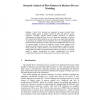Free Online Productivity Tools
i2Speak
i2Symbol
i2OCR
iTex2Img
iWeb2Print
iWeb2Shot
i2Type
iPdf2Split
iPdf2Merge
i2Bopomofo
i2Arabic
i2Style
i2Image
i2PDF
iLatex2Rtf
Sci2ools
97
Voted
BPM
2007
Springer
2007
Springer
Semantic Analysis of Flow Patterns in Business Process Modeling
Control flow elements are important in process models. Such elements usually appear in graphic models as splits and joins of activity sequences. Workflow patterns reflect possible executions of different configurations of splits and joins. However, despite the importance of process flow control and workflow patterns, no way exists yet to assure that a particular set of patterns is complete and non-redundant. We use an ontologically-based model of business processes to analyze the control configurations that can exist in a process model. A process is modeled in terms of state changes of the domain in which the process occurs. The state changes are controlled by laws which model the actions allowed in the domain. This model is notationindependent and enables incorporating goals into process analysis. We use the model to suggest classification of control configurations and identify configurations that assure the enacted process can always reach its goal.
Related Content
| Added | 07 Jun 2010 |
| Updated | 07 Jun 2010 |
| Type | Conference |
| Year | 2007 |
| Where | BPM |
| Authors | Pnina Soffer, Yair Wand, Maya Kaner |
Comments (0)

